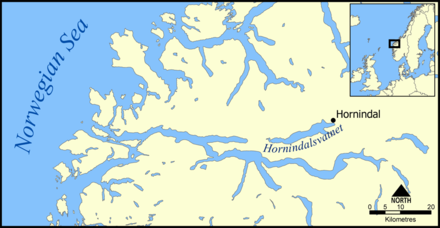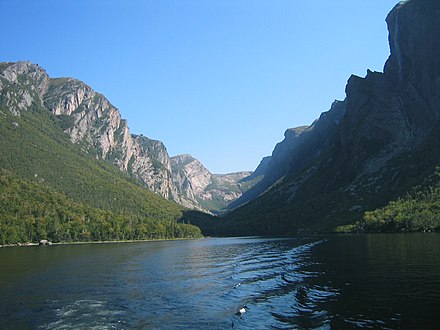.jpg/440px-Milford_Sound_New_Zealand._(16508409635).jpg) Fjords or fiords are long narrow inlets of the ocean often with steep sides or cliffs, created by a glacier. The two countries that are most known for their fjords are Norway and Canada, with New Zealand, Chile, Iceland, Scotland (where they are often just known as lochs) and Greenland (Denmark) also having a large number of fjords. There are some fjords in Alaska (US), Tasmania (Australia) and many European countries, but they may not be as well-known as the fjords in the former mentioned, but they are still spectacular sights to see.
Fjords or fiords are long narrow inlets of the ocean often with steep sides or cliffs, created by a glacier. The two countries that are most known for their fjords are Norway and Canada, with New Zealand, Chile, Iceland, Scotland (where they are often just known as lochs) and Greenland (Denmark) also having a large number of fjords. There are some fjords in Alaska (US), Tasmania (Australia) and many European countries, but they may not be as well-known as the fjords in the former mentioned, but they are still spectacular sights to see.
Understand
Fjords are formed by valley glaciers flowing down from their area of origin, through pre-existing river valleys. The original shape of the valley is overstated by the glacier, in that the ice pulls rock along with it and this further erodes the surrounding rock. The original valley, for example a notched valley, becomes wider and deeper and gets its typical U-shaped valley, also known as a trough valley, with very steep slopes. With the retreat of the glaciers, the sea is able to flow into the deep valleys.
 The depth of fjords can vary. In some cases, they may be no more than deep, while in others, the bottom can be more than below sea level. Typical for glacial fjords are relatively shallow thresholds at the mouth creating a relatively closed off basin within. Sognefjorden main basin is more than 1000 m deep while the threshold is some below the surface; there are thresholds at less than while the fjord within can be . There can be strong tidal currents at shallow and narrow thresholds.
The depth of fjords can vary. In some cases, they may be no more than deep, while in others, the bottom can be more than below sea level. Typical for glacial fjords are relatively shallow thresholds at the mouth creating a relatively closed off basin within. Sognefjorden main basin is more than 1000 m deep while the threshold is some below the surface; there are thresholds at less than while the fjord within can be . There can be strong tidal currents at shallow and narrow thresholds.
Sognefjorden is the second longest in the world and the largest glacier-free fjord complex. Unlike Greenland and Svalbard, mainland Norway's fjords does not have icebergs but inner branches may freeze over in cold winters.
In most places, the spelling of fjord is fjord except in New Zealand where the spelling fiord is the standard and is reflected in place names such as Fiordland National Park. In Canada, fiord is only used in proper names such as Grise Fiord, but it's fjord otherwise. The term is of Old Norse origin and adopted into English from Norwegian. The Icelandic cognate of the word is "fjörður". The original Old Norse meaning is related to crossing or travel as the word ford in English. An older term was angr and survived only as a suffix in names of some Scandinavian fjords and has in same cases also been transferred to adjacent settlements or surrounding areas for instance Hardanger, Stavanger and Geiranger. In many parts of Norway, fjord are not merely landscape features but, together with adjacent tangle of valleys, lakes, glaciers and islands, make up a particular type of landscape. The cognate for "fjord" in the Scots language is firth, though many of Scotland's fjords are simply known as "sea lochs", and not all firths are fjords in the geological sense.
Several Norwegian freshwater lakes that have formed in long glacially carved valleys and are frequently named fjords. Such "fjord-lakes" are very similar to saltwater fjords, and typically appear as extensions of the fjord. Some lake surfaces are barely above sea level while most of the lake can be several hundred meters below sea level. Hornindalsvatnet at more than is the deepest lake in Europe and most of the lake's volume is in fact below sea level. Many lowland lakes emerged from the saltwater during the post-glacial rebound. In a few rare cases saltwater has been trapped for several thousand years at the bottom of some deep lakes, known as meromictic lakes.
Fjords, and associated belt of islands, typically create a very fragmented coastline. Norway's coastline for instance is about 2,500 km measured along the shortest route but more than 25,000 km if fjords are included and 100,000 km if islands are also included. Only Canada has a longer coastline.
Destinations
Australia
- Macquarie Harbour near Strahan – a shallow fjord near the coastal town of Strahan and due to its sheer isolation, it was one of the toughest British penal settlements in the colony of Van Diemen's Land
- Port Davey in Southwest National Park – the only fjord of its size in Australia nestled in wilderness.
Canada
Newfoundland and Labrador
- Aviron Bay
- Bonne Bay in Gros Morne National Park
- Nachvak Fiord
- Saglek Bay
- Western Brook Pond in Gros Morne National Park
Nunavut
Nunavut has a large number of fjords with some of them located in Auyuittuq National Park:
- Alexandra Fiord
- Arviqtujuq Kangiqtua
- Baumann Fiord
- Grise Fiord
- Kangiqhuk
Costa Rica
- Golfo Dulce — considered one of only four tropical fjords in the world, but it's actually a "ria" (a drowned river valley that remains open to the sea).
Iceland
Iceland has a total of 109 fjords. The Westfjords and Eastfjords 📍 regions have particularly high concentrations of them, though there are also some fjords in West Iceland and along the North Coast. There are no fjords along the southern coast of Iceland.
- Hvalfjörður - the closest fjord to the capital Reykjavik.
- Eyjafjörður - one of Iceland's longest fjords, located on the north coast, with Akureyri, the largest town in Iceland outside the Southwest region, on its shores.
Montenegro
- Bay of Kotor — on the Adriatic, this is often purpoted to be the southernmost fjord in Europe. However, since it wasn't formed by glacier action, it is not a fjord but a ria — an ancient river valley submerged by the sea.
New Zealand
 New Zealand is the only place in the world where the spelling of fjord is fiord. Most of NZ's fiords can be found in the national park of Fiordland National Park.
New Zealand is the only place in the world where the spelling of fjord is fiord. Most of NZ's fiords can be found in the national park of Fiordland National Park.
- Milford Sound – the most visited and well known fiord of New Zealand
- Doubtful Sound
Norway
Main article: Fjords of Norway
- Fjords of Norway 📍 - Norway's more than 1000 fjords are found along the entire coast and the fjord districts cover about half of Norway's area, but the most dramatic fjord landscape is found in West Norway and parts of Northern Norway.
- Nærøyfjorden and Geirangerfjord are inscribed on UNESCO world heritage list.
- Hjørundfjord - picturesque fjord surrounded by breathtaking summits
- Sognefjord - the longest and deepest fjord
United States of America
- Puget Sound – a large fjord in Washington state, the city of Seattle is on its banks.
- Hudson River 📍 – in New York state, only the Upper Hudson River north of the Bear Mountain Bridge is a true river, while the Lower Hudson River geologically a fjord, with New York City on its banks, thus making it one of the world's most visited fjords.
- Kenai Fjords National Park
- Misty Fjords National Monument
